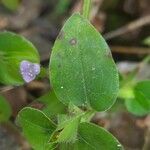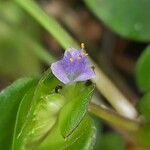A succulent herb. It is often creeping but can curve upwards. It keeps growing from year to year. The stems are 70 cm long. They form roots at the nodes. The leaves are sword shaped and 2-15 cm long by 4-12 mm wide. The base of the leaf clasps the stem. There are 2-6 flowers which do not have stalks and occur in the axils of leaves. They are blue-purple. The fruit is a capsule 6-7 mm long. The seed are brown and have several pits.



